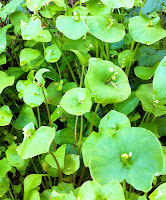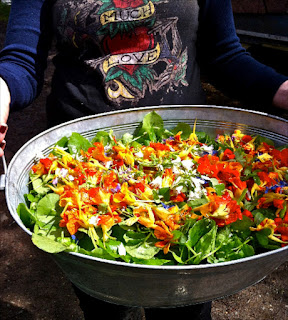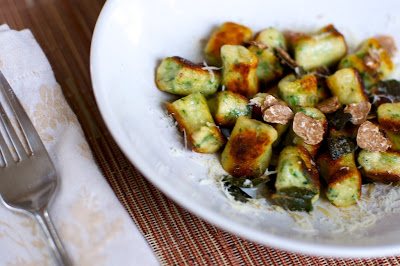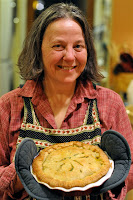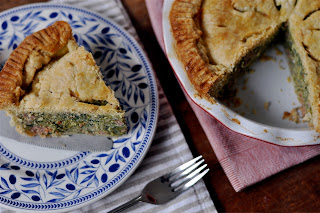SOMETIMES A KITCHEN experiment yields better results than you ever imagined. Substitute stinging nettles for spinach and you may never feel quite the same about a standard Saag Paneer again.
Stinging Nettle Paneer
3/4 lb paneer, cut into cubes
1 large onion
3-4 cloves garlic
1 4-inch thumb of ginger, peeled
2 tbsp vegetable oil, plus extra for frying paneer
3-4 cardamom pods, crushed
1/2 tsp cumin seeds
1/4 tsp ground cinnamon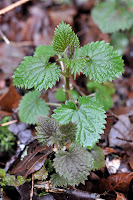
1/8 tsp ground cloves
1-2 plum tomatoes, diced
20 oz boiled nettles, drained
1/2 tsp turmeric
1 tsp ground cumin
1 tsp ground coriander
1 heaping tsp garam masala
1 tsp black pepper
1-2 tsp salt
1 cup, more or less, heavy cream or yogurt or a mix
cilantro for garnish
1. In a food processor, pulverize the onion, garlic, and ginger into paste.
2. Over medium heat, saute paste in oil for a few minutes in heavy-bottomed saucepan. Add cumin seeds, cardamom, cinnamon, cloves, and tomatoes, and cook for a minute or two, stirring occasionally.
3. Squeeze out excess water in boiled nettles. You’ll have a clump about the size of a baseball. Chop up by hand or with a food processor; I like mine well chopped, but not overly pulverized.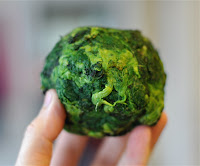
4. Add nettles to pan, along with tumeric, cumin, coriander, garam masala, black pepper, and salt. Stir together well.
5. Meanwhile fry paneer cubes in a little oil until lightly browned, then add to nettle mixture just before serving.
6. Finish over low heat with heavy cream or yogurt to desired consistency. Garnish with fresh cilantro.
***
Porcini Chana Masala
1/2 pound porcini mushrooms (or cremini), roughly chopped
1 can (14 oz) chickpeas, drained
1 medium onion
3-4 cloves garlic
1 4-inch thumb fresh ginger, peeled
2 tablespoons vegetable oil
2 teaspoons black mustard seeds
1 teaspoon fennel seeds
1 teaspoon cumin seeds
1 teaspoon coriander seeds
1 can (14 oz) diced tomatoes, drained
1 teaspoon ground turmeric
1/4 teaspoon ground cinnamon
1/8 tsp ground cloves
1/4 tsp cayenne pepper
1 tbsp lemon juice
1 tsp salt
1 tbsp brown sugar (optional)
1 cup (or more) water, stock, cream
cilantro for garnish
1. With a food processor make a paste with onion, garlic, and ginger.
2. Heat oil over medium heat in a large skillet. Add black mustard, fennel, cumin, and coriander seeds, and toast until mustard seeds start to pop (about 30 seconds or so). Note: do not overcook spices in oil or the curry will be bitter. Immediately add paste and tomatoes. Cook until liquid evaporates and mixture begins to brown.
3. In a separate pan, saute mushrooms in a little oil or butter until lightly browned. Add to skillet along with chickpeas. (I used previously sauteed and frozen porcini, and added directly after thawing.)
4. Add turmeric, cinnamon, cloves, cayenne pepper, lemon juice, salt, and a cup or so of water if necessary.
5. Cook uncovered over medium-low heat for 15 minutes. Adjust seasonings.
6. I finished my curry with a tablespoon of brown sugar and a half can (about a cup) of coconut milk, for a slightly sweeter curry. Garnish with fresh cilantro.
Cooking Indian at home can seem like a recipe for failure. All those spices! If you’re new to Indian cuisine, the first step is to visit your local spice store. You’ll want to have the basics: turmeric, cumin seeds, cardamom pods, ground coriander, garam masala, and so on. The amount of spices and seasonings will be overwhelming at first, but a little practice and before long you’ll be making your own adjustments to once-obscure seeming spices in a given recipe based on personal preference.
Like this:
Like Loading...
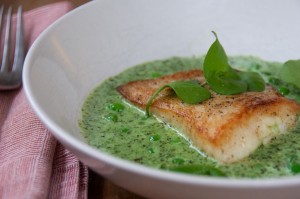 THIS SAUCE IS quick and easy if you happen to have stinging nettle pesto on hand. I always have some frozen at the ready.
THIS SAUCE IS quick and easy if you happen to have stinging nettle pesto on hand. I always have some frozen at the ready.








